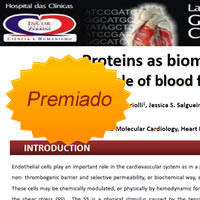
Proteins as biomarkers of Shear stress (SS) intensity: role of blood flow in atherosclerosis development |
Resumo do Pôster:Changes in SS intensities are highly associated to development and progression of atherosclerotic plaques1. Some vascular regions as in vessels with bifurcation, the laminar SS are decreased. In these regions there are increased endothelium permeability, alterations in the cytoskeleton and upregulation in adhesion molecules expression2. Many studies explored the relation between SS and atherosclerotic plaques, however little is known about the signaling pathways and changes involved in this process, and how this is associated with plaque vulnerability. This work aimed identifies and quantify proteins with differential expression between laminar and low SS, and connect these proteins to atherosclerosis development. To this, endothelial cells (HUVEC) were subjected to in vitro SS in a cone plate system. HUVECs Cells were submitted to low SS with 5 dynes (proatherogenic flow) and laminar SS with 15 dynes (atheprotective flow) during 24 hours. Total HUVEC proteins were mechanic extracted with 0,2% RapiGest in 50mM AMBIC buffer add protease inhibitor. Secreted proteins and intracellular proteins were measured by Bradford assay. 50ug of protein were denatured, reduced, alkylated and digested with trypsin 1:50. Peptides were analyzed by 1D nanoAcquity UPLC - Q Exactive hybrid mass spectrometer. Spectra were acquired over m/z 300−2000 at 70,000 resolution (m/z 200) and data-dependent acquisition selected the top 10 most abundant precursor ions for tandem mass spectrometry by HCD fragmentation using an isolation width of 1.2 Da, collision energy of 30, and a resolution of 35,000. Raw ?le was processed by MaxQuant in Label Free analysis, with FDR 1% and search in SwissProt database. Differential proteins were analyzed in Networks by Metacore. In total, 2728 proteins were found in proteome analysis. Proteins increased in 5 dynes SS are related to blood clotting, vascular development and cholesterol metabolism, whereas proteins upregulated in 15 dynes are related to inflammatory response, oxidative stress and tissue remodeling. In secretome analysis, 1235 proteins were found and protein related to apoptosis, chemokine for cell adhesion and vesicles formation are up secreted in 5 dynes stimuli, whereas in 15 dynes stimuli there are the increase of vasodilator proteins and hypoxia response. These findings corroborated with endothelial changes during atherosclerosis development and NO measure in media culture. Interestingly, we identified downregulation of every compounds participating in LDL receptor expression pathway in 5 dynes stimuli. These data suggest that laminar flow keep the expression of LDL receptor, activating LDL metabolism and avoiding the LDL inner in sub-endothelial space, in opposite of low SS. Subjects with mutation in LDL receptor show severe familial hypercholesterolemia with spontaneous plaque atherosclerosis formation3. We are currently replicating these data in vessels with different levels of atherosclerosis. All together our data suggest that intensity of SS have an important role atherosclerosis development and proteins could be useful as biomarker of vulnerability plaque. [1] Caro, C. G.; Fitz-Gerald, J. M.; Schroter, R. C. Nature. 1969, 223, 1159–60. |
